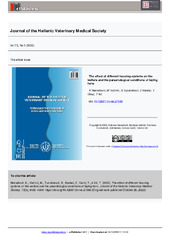Приказ основних података о документу
The effect of different housing systems on the welfare and the parasitological conditions of laying hens
| dc.creator | Nenadović, Katarina | |
| dc.creator | Vučinić, Marijana | |
| dc.creator | Turubatović, Radoslav | |
| dc.creator | Beckei, Zsolt | |
| dc.creator | Gerić, Tamara | |
| dc.creator | Ilić, Tamara | |
| dc.date.accessioned | 2022-12-29T15:26:35Z | |
| dc.date.available | 2022-12-29T15:26:35Z | |
| dc.date.issued | 2022 | |
| dc.identifier.issn | 1792-2720 | |
| dc.identifier.uri | https://vet-erinar.vet.bg.ac.rs/handle/123456789/2506 | |
| dc.description.abstract | The overwhelming majority of laying hens used for commercial egg production in the Serbia is con-fined in battery cages. By 2020, conventional cages will no longer be permitted in the Serbia and hens will be housed in furnished cages. The aim of this research was to assess the welfare of laying hens under the influence of different housing systems and analysis of the occurrence, maintenance, and spread of endoparasitic infections. The study was conducted during the winter season 2019/2020 on four rearing systems of Lohman Brown hens. For welfare assess-ment were used indicators from the Welfare quality assessment protocol for poultry which is grouped into 12 welfare criteria based on principles of good feeding, good housing, good health, and appropriate behavior. All fecal samples for parasites were qualitatively and quantitatively examined. The results showed that each housing system had positive and negative aspects but overall, hens in cage systems had the highest prevalence of poor plumage condition (47 % and 39%). Hens in conventional cages had more skin lesions (27%) than birds in other systems. Keel bone deformation was the most present in the aviary system (56%) while comb pecking wound in a conventional cage (33%) and free-range system (50%). Hens in the non cage had the highest prevalence of foot pad disorders (32% and 40%). In furnished cages, problems occurred in hens are the lowest. Parasitological examination diagnosed four groups of endoparasites: Coccidia, Trichostrongylidae and Heterakis spp, and Capillaria spp, with a total prevalence of 64% (64/100) only in free-range system. Laying hens in cage systems have a higher expression of negative emotions in relation to the aviary and free-range system. Evidence of negative hens’ emotional condition in cage systems and negative physical condi-tion across all housing systems, suggests that the welfare of modern hens in Serbia is impaired. | sr |
| dc.language.iso | en | sr |
| dc.publisher | eJournals | sr |
| dc.relation | info:eu-repo/grantAgreement/MESTD/inst-2020/200143/RS// | sr |
| dc.rights | openAccess | sr |
| dc.rights.uri | https://creativecommons.org/licenses/by-nc/4.0/ | |
| dc.source | Journal of the Hellenic Veterinary Medical Society | sr |
| dc.subject | animal welfare | sr |
| dc.subject | poultry | sr |
| dc.subject | housing system | sr |
| dc.subject | coccidia | sr |
| dc.subject | helminths | sr |
| dc.subject | behaviour | sr |
| dc.title | The effect of different housing systems on the welfare and the parasitological conditions of laying hens | sr |
| dc.type | article | sr |
| dc.rights.license | BY-NC | sr |
| dc.citation.volume | 73 | |
| dc.citation.issue | 3 | |
| dc.citation.spage | 4493 | |
| dc.citation.epage | 4504 | |
| dc.citation.rank | M23~ | |
| dc.identifier.doi | 10.12681/jhvms.27585 | |
| dc.identifier.fulltext | http://veterinar.vet.bg.ac.rs/bitstream/id/7205/The_effect_of_pub_2022.pdf | |
| dc.type.version | publishedVersion | sr |

